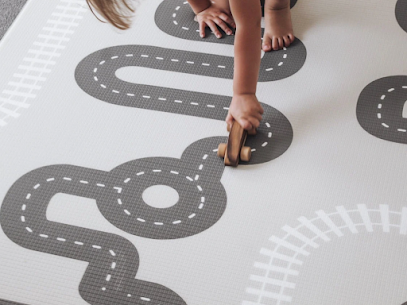As parents, we strive to create a playroom that not only caters to our children's needs but also inspires and engages them in meaningful ways.
Let's explore the essential must-haves for designing an exceptional playroom. From furniture and storage solutions to educational toys and imaginative play areas, we'll cover all the elements that make a playroom truly special.
Creating a playroom that sparks joy and encourages active learning requires careful consideration of the space's layout, organisation, and the selection of appropriate toys and materials.
We'll guide you through the process of choosing versatile furniture that maximises functionality while providing comfort and safety. We'll also look into the importance of storage solutions that keep toys tidy and easily accessible, promoting independent play and fostering a sense of responsibility.
Incorporating educational toys that help develop cognitive skills, stimulate creativity, and encourage problem-solving. From building blocks to puzzles, arts and crafts supplies to sensory play materials, we'll provide insights into selecting age-appropriate toys that support your child's growth and development.
But it's not just about functionality; we'll also dive into the world of imaginative play areas that transport children to different worlds and foster storytelling abilities. From cozy reading nooks to dramatic play corners, we'll discover how these dedicated spaces can ignite their imagination and enhance their social skills.
What are the essential elements in a Playroom?
1. Storage⠀

-
Organisation: Adequate storage solutions in a playroom help keep toys, games, and supplies organized, making it easier for children to find what they need and reducing clutter.
-
Safety: Proper storage ensures that toys and other playroom items are safely stored away when not in use, minimizing the risk of accidents or tripping hazards.
-
Maximizing Space: Utilizing storage options such as shelves, bins, and baskets helps optimize the use of space in the playroom, allowing for more room to play and move around.
-
Teach Responsibility: Having designated storage areas teaches children the importance of tidiness and taking care of their belongings. It encourages them to develop good habits of cleaning up after themselves.
-
Easy Access: Well-designed storage solutions provide easy access to toys and materials. This empowers children to independently engage in play and encourages their creativity and imagination.

-
Longevity: Proper storage helps protect toys and playroom items from damage, extending their lifespan and ensuring they remain in good condition for years to come.
-
Mental Clarity: An organised playroom with adequate storage minimises visual distractions, creating a calmer environment that can enhance focus and concentration during playtime.
-
Versatility: Various storage options allow for categorising toys based on type or theme, making it easier for children to find what they want to play with, fostering independence and creativity.
-
Transitioning Spaces: If the playroom needs to be repurposed or transformed into another space temporarily, efficient storage ensures a smooth transition by keeping items neatly stored away until needed again.
-
Encourages Rotating Toys: By having sufficient storage space, parents can rotate toys periodically. This keeps playtime fresh and exciting as children discover "new" toys while maintaining a clutter-free environment.
2. Comfortable flooring (such as a playmat)

-
Safety: A comfortable flooring option like a playmat provides a soft and cushioned surface, reducing the risk of injury during playtime, especially for young children who are prone to falls.
-
Comfort: Children spend hours playing on the floor, so having a comfortable surface helps ensure their comfort and enjoyment while engaging in various activities.
-
Supportive Surface: Playmats offer support for children's developing bodies, providing a gentle surface that eases the strain on their joints and muscles as they crawl, roll, and play.

-
Noise Reduction: Playmats can help absorb noise and impact, making the playroom a quieter environment. This is particularly beneficial if the playroom is located in an area where noise may disturb other family members or neighbors.
-
Hygiene: Playmats are typically easy to clean, making them a hygienic option for the playroom. They can be wiped down or easily removed for washing, ensuring a clean and safe play surface for children.
-
Aesthetics: Playmats come in various colors, patterns, and designs, allowing you to choose one that matches the aesthetic of your playroom. They can also be easily rearranged or replaced as needed to refresh the look of the space.
-
Defined Play Area: A playmat helps define a specific space within the playroom for play activities, creating boundaries and structure that can aid in organizing toys and keeping the room tidy.
-
Allergy-Friendly: Some playmats are hypoallergenic and resistant to allergens like dust mites, making them a suitable choice for children with allergies or sensitivities.
-
Thermal Insulation: Playmats can provide thermal insulation, ensuring that the floor remains warm during colder months. This allows children to comfortably engage in floor-based activities even when the weather is chilly.
3. Display for kids artwork ⠀

-
Encourages Creativity: Having a dedicated display area for children's artwork in the playroom celebrates their creativity and encourages them to express themselves through art.
-
Boosts Confidence: When children see their artwork proudly displayed, it boosts their confidence and self-esteem, fostering a sense of pride in their creations.
-
Appreciation for Art: Displaying children's artwork in the playroom helps cultivate an appreciation for art and encourages them to explore different artistic techniques and styles.
-
Family Bonding: A display area for children's artwork can serve as a conversation starter, allowing family members to engage in discussions about the artwork, the inspiration behind it, and the stories it tells.
-
Sense of Ownership: By showcasing their artwork, children develop a sense of ownership and responsibility for their creations, encouraging them to take care of their work and continue exploring their artistic abilities.
-
Inspiration: When children see their artwork displayed alongside the work of others, it can inspire them to try new techniques or experiment with different mediums, fostering ongoing artistic growth.
-
Personalised Space: Displaying children's artwork adds a personal touch to the playroom, making it feel like their own special space where they can proudly showcase their talents.
-
Recognition and Appreciation: Displaying children's artwork shows that their efforts are valued and appreciated by the entire family. It provides an opportunity for parents and siblings to admire and acknowledge their creativity.
4. Table & Chairs⠀

-
Creative Play: Tables and chairs provide a designated space for children to engage in various creative activities such as drawing, colouring, building with blocks, or playing with playdough.
-
Learning and Development: Having tables and chairs in the playroom allows children to sit comfortably while engaging in educational activities like puzzles, board games, or completing homework.
-
Social Interaction: Tables and chairs create a gathering space where children can come together to collaborate, share ideas, and engage in cooperative play, fostering social skills and teamwork.
-
Comfort and Ergonomics: Properly sized tables and chairs designed for children ensure their comfort and support good posture during playtime or study sessions.

-
Independence and Autonomy: Providing child-sized furniture empowers children to independently choose their activities, set up their play area, and take responsibility for their belongings.
-
Multifunctional Space: Tables and chairs can serve as a versatile surface for different activities, from arts and crafts to snack time or even hosting tea parties with friends.
-
Pretend Play Enhancements: With tables and chairs, children can transform their play area into a pretend restaurant, classroom, or office, promoting imaginative play and storytelling.
5. Cozy reading nook⠀

-
Reading Encouragement: A cozy reading nook in the playroom creates an inviting space that encourages children to develop a love for reading and storytelling.
-
Comfort and Relaxation: A dedicated reading nook provides a comfortable and relaxing spot where children can curl up with their favourite books, plush pillows, and soft blankets.

-
Quiet Retreat: A reading nook offers a quiet and peaceful space away from distractions, allowing children to immerse themselves in the world of books and escape into their imagination.
-
Literacy & Language Development: Having a designated area for reading promotes literacy development by providing a space where children can engage in independent reading or have storytime with parents or siblings.
-
Mindfulness and Relaxation: A quiet nook in the playroom provides a space for children to practice mindfulness, deep breathing, or relaxation techniques while enjoying a good book.
-
Bonding Opportunities: A reading nook can be a shared space where parents and children can bond over stories, engage in dialogue about the books they read together, and create lasting memories.
-
Lifelong Love for Reading: By providing a comfortable and inviting reading nook in the playroom, parents can instils a lifelong love for reading in their children, promoting continuous learning and personal growth.
6. Hideaway spot⠀

-
Imaginative Play: A hideaway spot like a tent provides children with a designated area for imaginative play, allowing them to create their own little world and engage in pretend adventures.
-
Privacy and Solitude: A tent offers a private and secluded space where children can retreat, recharge, and have some quiet time alone if they desire.
-
Cozy Retreat: Tents provide a cozy and comforting space where children can snuggle up with their favourite toys, books, or blankets, creating a sense of security and relaxation.

-
Encourages Role-Play: Tents can serve as a stage for role-play scenarios, such as camping trips, picnics, or even creating a mini-home, allowing children to explore different roles and develop social skills.
-
Versatility: Tents come in various designs and themes, allowing children to choose one that suits their interests or matches their imaginative play scenarios. They can transform into castles, spaceships, or magical hideouts.
-
Social Interaction: Tents can accommodate multiple children, providing a space for cooperative play and fostering social interaction as they engage in imaginative games together.
-
Safe Haven: A tent can serve as a safe haven for children when they feel overwhelmed or need a place to calm down. It gives them a designated space to retreat to and regroup their thoughts and emotions.
-
Boundary Setting: Having a tent in the playroom helps establish boundaries and define play areas, creating structure and organisation within the space.
7. Dress ups ⠀

-
Encourages Imagination: Dress-up items in the playroom provide children with the opportunity to use their imagination and step into different roles and characters, fostering creativity and storytelling abilities.
-
Role-Play and Social Skills: Dress-ups allow children to engage in role-play scenarios, such as pretending to be doctors, firefighters, or superheroes. This promotes social interaction, cooperation, and the development of empathy.

-
Self-Expression: Dressing up in different costumes allows children to express themselves and explore their personal interests, preferences, and identities in a safe and playful manner.
Written by Laura Agrimi, mother of 2 and owner of Grace & Maggie.

Grace & Maggie
Online store - Open 24 hours
orders@graceandmaggie.com.au
PO Box 2852, Cheltenham, VIC 3192
Melbourne, Victoria, Australia




 Shop Now with Afterpay
Shop Now with Afterpay 









